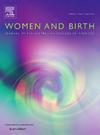The professional experience of rural midwifery in China during the transition from traditional to modern birth practices (1950s–1970s): A qualitative study
IF 4.1
2区 医学
Q1 NURSING
引用次数: 0
Abstract
Background
Although home births have been largely discontinued in contemporary China, traditional birth attendants (TBAs) historically played a pivotal role in enhancing maternal and child health, particularly in rural areas.
Aim
This study explored the transformation of TBAs in China from the 1950s to the 1970s, focusing on their gradual shift from traditional to modern midwifery practices. By drawing on oral histories from TBAs, the research seeks to enrich the historical understanding of midwifery development in China.
Methods
A descriptive phenomenological methodology was adopted to explore the professional experience, perspectives, and sociocultural contexts of TBAs. Data were gathered through semi-structured, in-depth interviews.
Findings
Analysis yielded five major themes and four sub-themes: (1) Intentional staff selection; (2) Purposeful pre-service training, with two sub-themes including (a) variation in training duration and the rarity of retraining, and (b) a predominantly practical, hands-on focus; (3) Accumulation of practical experience, with two sub-themes including (a) advocacy for natural childbirth with minimal intervention, and (b) practicing based on experience and contextual adaptation; (4) In-home postpartum care; (5) Recognition of professional value.
Conclusions
During the transitional phase from traditional to modern midwifery in China, TBAs were provided with limited yet pragmatic training before assuming their roles. Despite the inherent safety risks and a lack of formal medical oversight, TBAs made critical contributions to maternal and neonatal health in the context of severely limited medical infrastructure. Their presence and practices not only addressed urgent reproductive health needs in underserved areas but also gradually facilitated the shift of childbirth from the domestic sphere to institutional hospital settings.
中国农村助产专业经验从传统到现代的转变(1950 - 1970):一项质的研究
尽管在当代中国,家庭分娩已基本停止,但传统助产士(tba)在促进妇幼健康方面一直发挥着关键作用,特别是在农村地区。目的本研究探讨了20世纪50年代至70年代中国助产士的转变,重点关注他们从传统助产士实践到现代助产士实践的逐渐转变。通过借鉴助产士的口述历史,本研究旨在丰富对中国助产学发展的历史认识。方法采用描述现象学研究方法,探讨传统文化工作者的职业经历、观点和社会文化背景。数据是通过半结构化的深度访谈收集的。调查结果分析得出五个主要主题和四个副主题:(1)有意的员工选择;(2)有目的的职前培训,包括两个子主题,包括(a)培训时间的变化和再培训的稀缺性,以及(b)以实际操作为主;(3)实践经验的积累,有两个子主题,包括(a)倡导最小干预的自然分娩,(b)基于经验和情境适应的实践;(4)家庭产后护理;(5)专业价值的认可。结论在中国传统助产学向现代助产学的过渡阶段,助产士在发挥作用之前接受了有限但实用的培训。尽管存在固有的安全风险和缺乏正式的医疗监督,但在医疗基础设施严重有限的情况下,传统助产士对孕产妇和新生儿健康作出了重要贡献。她们的存在和做法不仅解决了服务不足地区的紧急生殖健康需求,而且还逐渐促进了将分娩从家庭领域转移到机构医院环境。
本文章由计算机程序翻译,如有差异,请以英文原文为准。
求助全文
约1分钟内获得全文
求助全文
来源期刊

Women and Birth
NURSING-OBSTETRICS & GYNECOLOGY
CiteScore
7.20
自引率
13.20%
发文量
371
审稿时长
27 days
期刊介绍:
Women and Birth is the official journal of the Australian College of Midwives (ACM). It is a midwifery journal that publishes on all matters that affect women and birth, from pre-conceptual counselling, through pregnancy, birth, and the first six weeks postnatal. All papers accepted will draw from and contribute to the relevant contemporary research, policy and/or theoretical literature. We seek research papers, quality assurances papers (with ethical approval) discussion papers, clinical practice papers, case studies and original literature reviews.
Our women-centred focus is inclusive of the family, fetus and newborn, both well and sick, and covers both healthy and complex pregnancies and births. The journal seeks papers that take a woman-centred focus on maternity services, epidemiology, primary health care, reproductive psycho/physiology, midwifery practice, theory, research, education, management and leadership. We also seek relevant papers on maternal mental health and neonatal well-being, natural and complementary therapies, local, national and international policy, management, politics, economics and societal and cultural issues as they affect childbearing women and their families. Topics may include, where appropriate, neonatal care, child and family health, women’s health, related to pregnancy, birth and the postpartum, including lactation. Interprofessional papers relevant to midwifery are welcome. Articles are double blind peer-reviewed, primarily by experts in the field of the submitted work.
 求助内容:
求助内容: 应助结果提醒方式:
应助结果提醒方式:


